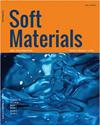Hydroxyapatite incorporated bacterial cellulose hydrogels as a cost-effective 3D cell culture platform
IF 1.4
4区 材料科学
Q4 MATERIALS SCIENCE, MULTIDISCIPLINARY
引用次数: 3
Abstract
ABSTRACT For cell and tissue physiology research, drug discovery, and growing replacement tissues for regenerative medicine, accurate and cost-efficient in vitro techniques are increasingly demanded. The conventional model for in vitro cell culture is the two-dimensional (2D) culture. Yet, cells have been found to be more native when they are grown in 3D conditions. We present here the development and evaluation of biological properties of bacterial cellulose/hydroxyapatite (BC/HA) nanocomposite hydrogel as a potential 3D cell-culture platform. The synthesized composites were characterized using Scanning Electron Microscopy (SEM), Atomic Force Microscopy (AFM), Swelling measurements and Celltiter 96® Aqueous One Solution Cell Proliferation Assay (MTS) using mouse fibroblast cell line (L – 929). The arrangement of composites shown in SEM and AFM images closely resembles the native extracellular matrices (ECM) showing the potential to act as a viable substrate for cell culture. The composites exhibited high swelling ratio (5.31–5.81), indicating enhanced moisture absorption and potential for nutrient exchange. The in vitro biocompatibility results indicated significantly high percentage cell proliferation (85.20%-88.30%). These findings indicate that the BC/HA composites are potential candidates for 3D cell-culture applications.羟基磷灰石结合细菌纤维素水凝胶作为一个具有成本效益的3D细胞培养平台
对于细胞和组织生理学研究、药物发现和再生医学中生长的替代组织,越来越需要精确和经济高效的体外技术。体外细胞培养的传统模型是二维(2D)培养。然而,已经发现细胞在3D条件下生长时更加原生。我们在此介绍了细菌纤维素/羟基磷灰石(BC/HA)纳米复合水凝胶作为潜在的三维细胞培养平台的生物学特性的开发和评估。采用扫描电镜(SEM)、原子力显微镜(AFM)、肿胀测量和Celltiter 96®水溶液细胞增殖试验(MTS)对合成的复合材料进行了表征,实验采用小鼠成纤维细胞系(L - 929)。SEM和AFM图像显示的复合材料的排列与天然细胞外基质(ECM)非常相似,显示出作为细胞培养可行底物的潜力。复合材料具有较高的溶胀率(5.31-5.81),表明复合材料具有较强的吸湿性和养分交换潜力。体外生物相容性结果显示细胞增殖率显著提高(85.20% ~ 88.30%)。这些发现表明,BC/HA复合材料是3D细胞培养应用的潜在候选者。
本文章由计算机程序翻译,如有差异,请以英文原文为准。
求助全文
约1分钟内获得全文
求助全文
来源期刊

Soft Materials
工程技术-材料科学:综合
CiteScore
2.90
自引率
0.00%
发文量
21
审稿时长
2.2 months
期刊介绍:
Providing a common forum for all soft matter scientists, Soft Materials covers theory, simulation, and experimental research in this rapidly expanding and interdisciplinary field. As soft materials are often at the heart of modern technologies, soft matter science has implications and applications in many areas ranging from biology to engineering.
Unlike many journals which focus primarily on individual classes of materials or particular applications, Soft Materials draw on all physical, chemical, materials science, and biological aspects of soft matter. Featured topics include polymers, biomacromolecules, colloids, membranes, Langmuir-Blodgett films, liquid crystals, granular matter, soft interfaces, complex fluids, surfactants, gels, nanomaterials, self-organization, supramolecular science, molecular recognition, soft glasses, amphiphiles, foams, and active matter.
Truly international in scope, Soft Materials contains original research, invited reviews, in-depth technical tutorials, and book reviews.
 求助内容:
求助内容: 应助结果提醒方式:
应助结果提醒方式:


